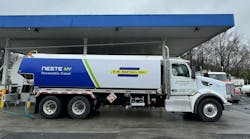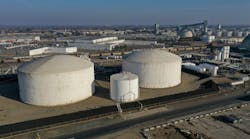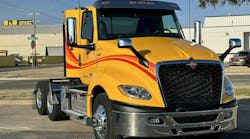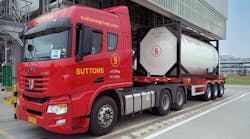In the North American marketplace for more than a year, Volvo’s No Regen Selective Catalytic Reduction (SCR) technology has rapidly become the EPA’10 system of choice as more and more customers gain experience with the product.
The most tested products in the history of Volvo Trucks North America, Volvo’s EPA’10 trucks with SCR can deliver a 5% or more fuel efficiency improvement and near-zero nitorgen oxide (NOx) and particulate emissions.
Volvo is part of the first heavy-duty truck manufacturing group to receive EPA’10 certification, without the use of emissions credits, and began filling customer orders with production engines in autumn 2009.
Volvo’s EPA’10 system consists of its fuel-efficient D11, D13, and D16 engines coupled with SCR exhaust aftertreatment technology.
“Using aftertreatment—removing the targeted NOx downstream rather than in-cylinder—allows the engine to be retuned for maximum fuel efficiency,” said Ed Saxman, Volvo’s powertrain product manager.
US-based Heritage Transport and Canada-based Challenger Motor Freight were among the first to embrace Volvo’s EPA’10 system and experience the benefits it has to offer.
Heritage is a wholly owned subsidiary of Heritage Environmental LLC, a full-service nationwide environmental systems provider that transports, stores, and disposes of hazardous waste materials. Headquartered in Indianapolis IN, Heritage operates 217 trucks, the majority of which are Class 8 tandem axle box trucks and tandem axle tractors. The company runs a 24-hour/five-days-a-week operation with 115 day cabs and 102 sleepers.
In 2009, Heritage evaluated its options for converting to EPA’10 product and chose Volvo for its No Regen SCR technology and commitment to quality, the environment, and safety. The company placed an initial order for nine VN 630s with D13 500-hp engines and SCR in August 2009, and will have a total of 32 Volvo EPA’10 trucks operating by the end of 2011.
“As a ‘green’ company, we knew we wanted to be among the very first to embrace the new, cleaner trucks,” said Dean DeSantis, president of Heritage Transport. “We came to the conclusion that Volvo’s EPA 2010 solution was leading edge, and we certainly wanted to be a company that was on the leading edge of cleaning up the environment.”
Challenger, too, saw the early adoption of Volvo’s EPA’10 system as one aspect of its environmental commitment. Headquartered in Cambridge, Ontario, the Challenger Group operates out of LEED-certified building, is an EPA SmartWay program partner, and strategically uses Longer Combination Vehicles (LCVs) to meet capacity demands while reducing its carbon footprint. The company employs more than 2,300 people and operates approximately 1,500 trucks and 3,300 trailers. It is the largest privately owned truckload carrier in Canada and the sixth-largest trucking company in the country.
Challenger put five Volvo SCR-equipped trucks into service for long-haul operations December 31, 2009. One year later, the company is operating 91 2010 Volvo VNLs. An additional 90 Volvos are on order for 2011.
Like many North American carriers, Challenger’s management knew the move to EPA’10 trucks was inevitable—but had reservations. Before signing on, Challenger Chief Executive Officer Dan Einwechter traveled to Europe to experience Volvo’s SCR technology and meet with other carriers.
“That really put my mind at ease about SCR,” Einwechter said. “I am now firmly in the SCR camp. The alternative solutions are unacceptable to me.”
Challenger’s experience with Volvo’s SCR technology has been “exceptional,” according to Einwechter.
“While the long-term journey has to be assessed, so far the Volvo EPA’10 engines have been above and beyond what we anticipated,” he said.
“Volvo told us that we would have good engine performance, that the fuel economy would improve and that the use of Diesel Exhaust Fluid (DEF) would pose no problems, even in the very cold temperatures we have in Canada,” Einwechter said. “Volvo said it, and we experienced it. We’ve had no problems at all.”
SCR works by injecting DEF into the exhaust stream only as required. DEF is nothing more than a mix of two-thirds water and one-third urea, which is a common nitrogen-containing compound. DEF works with the heat of the exhaust and a catalyst to convert NOx into nitrogen and water vapor.
Drivers, too, are satisfied with the new Volvo trucks.
“Other than topping off the DEF every few refuels, the SCR technology is transparent to the driver,” explained Saxman.
When the new trucks were introduced at Challenger, the company focused on educating drivers.
“We spent a lot of time with the teams that were driving the five initial trucks,” said Einwechter. “These early adopters spread the word and we’ve been fine with all our drivers.”
At Heritage, drivers like the maneuverability, power, and tremendous torque that the new trucks provide, as well as the ease of the SCR system. Drivers simply refill DEF at their terminals every two or three days.
“Volvo’s EPA’10 solution has been a complete success,” DeSantis said. “It’s a great technology and a great product. It is the right solution to meet the standards.”
Order for Class 8 trucks equipped with EPA’10 certified Volvo Group engines—which include the Volvo D11, D13, and D16—have already surpassed the 25,000 mark.








